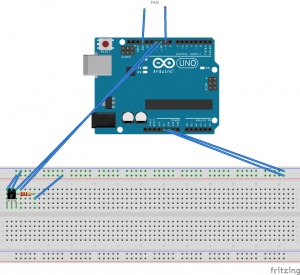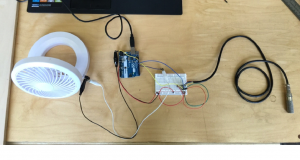Dean Ciofani
Sean Mckensie
PJ Niedzwicki
The concept for our project is taking a measurable environmental variable, translating this variable, and
altering the immediate environment. Currently the system is setup to measure the humidity of the
room, and then translate this data to what is colloquially known as an “if then” statement. If the
humidity is deemed too high, according to written the program, then the system provides power to a
fan.
Concept Diagram
Circuit Diagram
Prototype Photograph
Code Used
// LED connected to digital pin 9
// Digital pins with the ~ are able to do fading also known as PWM
int musclePin = 8;
// Setting my musclewire to pin 9
int repeat;
unsigned long time;
#include <SHT1x.h>
// Specify data and clock connections and instantiate SHT1x object
// I installed the SHT1x library into the sketchbook
#define dataPin 10
// data pin is the blue wire
#define clockPin 11
// clock is the yellow wire
SHT1x sht1x(dataPin, clockPin);
void setup()
{
Serial.begin(9600); // Open serial connection to report values to host
Serial.println(“Starting up”);
pinMode(ledPin, OUTPUT);
pinMode(musclePin, OUTPUT);
}
void loop()
{
float temp_c;
float temp_f;
float humidity;
// Read values from the sensor
temp_c = sht1x.readTemperatureC();
temp_f = sht1x.readTemperatureF();
humidity = sht1x.readHumidity();
// Print the values to the serial port
Serial.print(“Temperature: “);
Serial.print(temp_c, DEC);
Serial.print(” C / “);
Serial.print(temp_f, DEC);
Serial.println(” F.”);
Serial.print(“Humidity: “);
Serial.print(humidity);
Serial.println(“%”);
time =millis();
Serial.print(“Time: “);
Serial.println(time);
delay(repeat);
if(humidity <= 70 || humidity == 100){
digitalWrite(musclePin, HIGH);
for (int fadeValue = 0 ; fadeValue <= 255; fadeValue++) {
// sets the value (range from 0 to 255):
analogWrite(ledPin, fadeValue);
// wait for 30 milliseconds to see the dimming effect
delay(5);
}
// fade out from max to min in increments of 5 points:
for (int fadeValue = 255 ; fadeValue >= 0; fadeValue–) {
// sets the value (range from 0 to 255):
analogWrite(ledPin, fadeValue);
// wait for 10 milliseconds to see the dimming effect
delay(5);
repeat = 0;
}
}
else
digitalWrite(musclePin, LOW);
digitalWrite(ledPin, LOW);
}
Code (semi)optimized
int fanPin = 8;
int repeat;
unsigned long time;
#include <SHT1x.h>
#define dataPin 10
SHT1x sht1x(dataPin);
void setup()
{
Serial.begin(9600); // Open serial connection to report values to host
Serial.println(“Starting up”);
pinMode(fanPin, OUTPUT);
}
void loop()
{
float temp_c;
float temp_f;
temp_c = sht1x.readTemperatureC();
temp_f = sht1x.readTemperatureF();
humidity = sht1x.readHumidity();
// Print the values to the serial port
Serial.print(“Temperature: “);
Serial.print(temp_c, DEC);
Serial.print(” C / “);
Serial.print(temp_f, DEC);
Serial.println(” F.”);
if(temperature <= 70 || temperature == 100){
digitalWrite(fanPin, HIGH);
for (int fadeValue = 0 ; fadeValue <= 255; fadeValue++) {
// sets the value (range from 0 to 255):
delay(5);
}
// fade out from max to min in increments of 5 points:
for (int fadeValue = 255 ; fadeValue >= 0; fadeValue–) {
// sets the value (range from 0 to 255):
// wait for 10 milliseconds to see the dimming effect
delay(5);
repeat = 0;
}
}
else
digitalWrite(fanPin, LOW);
}
![diagram [Converted]](http://cast.b-ap.net/arc593f15/wp-content/uploads/sites/33/2015/12/diagram-Converted-300x122.png)

